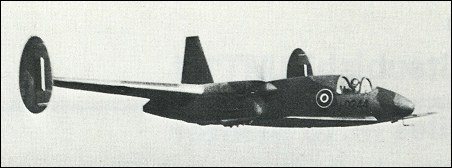|
| The M.35 was completed and flown in six weeks but proved to be unstable. Wind tunnel tests showed the problems to be curable and George Miles conceived a heavy bomber, the M.39, to be powered by three turbojet engines, or in its initial form with two high-altitude Rolls-Royce Merlin 60s or Bristol Hercules VIIIs.
A five-eighths scale model of the bomber was built and designated M.39B, flying for the first time on 22 July 1943 and proving to be aerodynamically stable. Flight trials were initially on a private basis, but in 1944 the M.39B went to the Royal Aircraft Establishment
at Farnborough, where it suffered two accidents. After extensive repairs the work ended.
| MODEL | M.39B Libellula |
| ENGINE | 2 x de Havilland Gipsy Major 1C, 104kW |
| WEIGHTS |
| Take-off weight | 1270 kg | 2800 lb |
| Empty weight | 1091 kg | 2405 lb |
| DIMENSIONS |
| Wingspan | 11.43 m | 38 ft 6 in |
| Length | 6.76 m | 22 ft 2 in |
| Height | 2.82 m | 9 ft 3 in |
| Wing area | 23.15 m2 | 249.18 sq ft |
| PERFORMANCE |
| Max. speed | 264 km/h | 164 mph |
| John Hunton, e-mail, 24.12.2024 18:22 I have built several unusual RC models and my protocol for finding the proper CG is to build a scaled sheet balsa glider of the subject, determine the best balance point of the glider and use that as a beginning point for the RC model. reply |
| Frank Doerle, e-mail, 21.08.2015 21:33 I am in the process of drwaing up plans for a 1 /5 scale RC model and would like to get some CG info on the M.39B. Any help woul be appreciated. reply |
|
Do you have any comments?
|
| 
COMPANY
PROFILE
All the World's Rotorcraft
|







Greetings Mr. Hunton,
Let me apologize in advance, this is going to be a little "long winded".
What a surprise! I'm doing some research for a build, and boom, I see you've posted here.
First off, I'm making an assumption, dangerous though it may be, that you are in Culpepper, Virginia. Or at least you were 25 years ago. Yeah, it's been a long time.
You were a revered member of the R /C club that I joined some 30 years ago. I already knew who you were as I'd been reading your articles in the model magazines. But I didn't know you were a member of this club.
During the last club meeting I attended, you gave a presentation on the giant scale Stinson Reliant you were building. After the meeting we talked for a bit, and I ended up following you back to your place so you could show me something that was in your "shop". I recall there was an old radial engine on a stand outside the door to your shop. You explained that it was from the Stinson Reliant that you had once owned. I had my son (he was 7 or 8) with me at the time and you presented him with an AMA Cub (Dart?) rubber powered stick and tissue kit. We built it later that evening and flew it for the next week. My son learned some valuable lessons that week. Over the course of that week we made many repairs to that little plane. One evening, he had been flying it in the yard, and it hit a tree and cracked a leading edge. Again.
He came in and told me it was broke again, then told me he had to go fix it. I asked if he needed help, but he assured me he could do it himself as he headed to the work room. About 2 minutes later I hear, "Daddy, I need your help." While using the CA, he had glued himself to the model and the model to the work table. He's never done that since.
Myself, I learned something new every time I was in your presence. One of the things I learned helped me out, in a big way last fall. I promised myself that if I ever got the chance, I was going to tell you about it, and thank you for sharing your knowledge with me.
I was flying an Aeronca Champ (full scale), and was practicing spins. Usually, I only did a turn or two before recovering. This time though, I decided to challenge myself and see how many turns I could do if I Started at 7,000 (AGL) and recovered by 3,000 (AGL). I made the long climb to 7,000 feet and started the spin. At about 5,500 feet something happened that I hadn't counted on. The prop stopped.
So, time for some back story here.
At some point in the late 1980's, this Champ was flipped onto its back during a botched landing. For the next 6 or 7 years the plane served as a parts "donor" as it sat up against the back wall of the hanger. In 1994, someone bought this pile of Champ and "rebuilt" it. It is now parts of 3 different Champs that fly in formation. It has parts from 1947, 48, and 49. (Somebody painted "Franken-Champ" on the rudder.) For this reason, among others, the plane is now registered as experimental. So, now you're up to date.
This Champ doesn't have an electric starter. I instantly remembered something I'd heard from you. I stopped the spin but kept the nose down. The prop blades began flipping past, S L O W L Y. One compression stroke at a time, after 3 or 4 blades I had the timing down and as it was coming up on the next compression stroke, I shoved the stick and the rudder to the left stops. After 2 "chuuga chugga's" the engine lit off and was running again. I eased the stick back and after the speed came down a bit, rolled the throttle back in. For whatever reason, I decided to go make a low pass over the field I had chosen in case I had to land. I was down to about 75 feet before I saw the field wasn't as nice and clear as I thought. If I'd landed there, the Champ would have probably ended up on it's back, again. So, you saved me from having to make an off field landing, and probably more. As I climbed away from that field and headed home, I said a little prayer of thanks. It ended with, "God bless you John Hunton."
reply